Using the CBL School Design Rubric to Refine and Deepen Work in one New Hampshire School District
CompetencyWorks Blog
In 2018, Vander Els and Stack introduced a school design rubric to assist educators with developing a plan for competency-based learning (CBL) implementation in their schools and/or school districts. To understand how the rubric can be used effectively to advance competency-based learning, consider this perspective from School Administrative Unit 7 (SAU 7) in New Hampshire, a rural school district of three schools that began using the tool first in 2020.
The rubric is based on the Aurora Institute’s seven design principles of competency-based education. The rubric appeared in their first book, Breaking With Tradition The Shift to Competency-Based Learning in PLCs at Work™ published by Solution Tree. The current design rubric, revised in 2022, appears in their second Solution Tree book, Unpacking the Competency-Based Classroom: Equitable, Individualized Learning in a PLC at Work®.
Each design principle is unpacked into a series of two to three indicators, each with descriptors to help readers understand what the indicator should look like at the initiating, developing, and finally, the performing levels. The tool has been used by educators globally for the purposes of self-reflection, development of school-wide implementation plans, and/or for progress monitoring of a competency-based learning system in their classrooms, schools, and school districts.
About SAU 7: A Rural Community with a Self-Directed and Collaborative Spirit
SAU 7 is a regional administrative unit, similar to a district, located in the northernmost part of Coos County, New Hampshire. SAU 7 serves five towns across more than 500 square miles of diverse terrain, which includes the headwaters of the Connecticut River and the scenic northern White Mountains region.
Given its remote location, the district has built a strong sense of community and independence, serving just over 300 students. Its rural setting inspires its staff to innovate in every area of their educational approach – from professional development and curriculum to instruction, assessment, special education, and technology.
To meet the district’s unique needs, schools share staff, conduct online professional development and committee meetings when needed, and work collaboratively across all three of its schools. This teamwork ensures high-quality outcomes in the most efficient way possible.
The dedication and contributions of the teachers and staff are essential. Their combined efforts create a collaborative spirit that enhances teaching and learning across the district. The educators here are on a long educational journey, with a guiding coalition of school administrators and teacher leaders driving progress through professional development, professional learning communities, and ongoing curriculum enhancement.

Getting Started with a Shift to CBL
Early in the 2019-2020 school year, the SAU 7 administrative team was brainstorming the manner in which they could effectively go about transitioning the three schools not only to a competency-based system of learning, but also into a more cohesive, collaborative unit with consistency and alignment between all schools. They knew it would be no easy task and it would be best to find thought partners who had been through the process to guide the way.
The team arranged a visit to another New Hampshire school system that Stack and Vander Els had worked with on a systemwide transition to CBL. After this visit, the team excitedly planned to move forward with CBL in SAU 7. Wasting no time, Brian and Jon were invited to SAU 7 for the March 2020 professional development day to speak to the staff. Plans changed quickly, though, as NH Governor Sununu announced a week prior to the workshop that, due to COVID-19, schools in NH were closing indefinitely.
Fear not, a seed had been planted and the SAU 7 team was eager to move forward. In October 2020, SAU 7 held their first all-staff meeting with Stack and Vander Els in which they introduced CBL. Teams were given the task of identifying what elements of CBL already exist in SAU 7, what barriers existed, and what was in place that could be utilized to advance forward. The overwhelming majority of responses indicated what had been known for years: teachers didn’t have time to meet and collaborate with other teachers at their grade or subject level. Adding to this barrier was the fact that the northernmost and southernmost schools of SAU 7 are 13 miles apart.
Establishing Effective PLCs
One of the first necessary tasks to implement at each school and across the district was effective Professional Learning Community structures and mindsets. To many, the district was facing a barrier the size of Mount Everest. Not only was it dealing with COVID-19 and hybrid learning, there was now a new initiative rolling in and teachers were being asked to collaborate in a PLC…all via Zoom! With an abundance of guidance and a positive mindset, teachers received thorough professional development around PLCs as well as Quality Performance Assessments (QPAs). A scaffolded process allowed teams to work on creating a QPA and rubric in the subject of their choice, pilot the assessment with their students, and bring back work samples to their collaborative teams. Using these work samples, teams conducted a student validation protocol, which allowed them to make necessary adjustments to the QPA and/or rubric as necessary, allowing the necessary rigor to be at the center of the QPA.
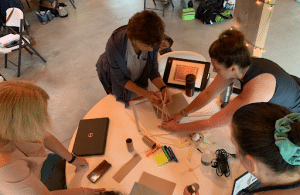
After this cycle, the majority of teams began to feel more positive about their collaborative work and this shift. They started to see, first-hand, how this was beneficial to their students. Teachers felt good about being able to assess their students on the aligned standards, knowing that what was being assessed was relevant and not random. They had motivation to move forward and continue, which is exactly what almost 50% of the district did at a Summer Institute led by Stack and Vander Els that June.
The Institute was like a steam engine that got the momentum going. Teachers left there excited to share what they’d learned and done with the rest of the staff in the Fall. There was an evident shift in mindset going into the 2021-2022 school year. Listening to teachers talk, it was evident that assessment literacy was increasing as well. The way teachers talked about assessment, alignment, and data had completely shifted. In addition, teachers were able to work in person again, as COVID-19 restrictions had finally been lifted. It was the boost teachers needed to continue pushing forward.
Teachers immersed themselves in this work at every early release and administrative day over the next year. Stack and Vander Els worked diligently with teachers and the administrative team throughout the year, to help advance this work. The Curriculum Director, Jennifer Mathieu, used examples of competency statements from other New Hampshire school districts to develop a guide for SAU 7’s core subjects, K-12. Teams met with her a few times throughout the year to determine learning targets, priority standards, and supporting standards. A competency document was created for each course with aligned essential standards and learning targets.
Building To a Coherent System with Assessment Mapping
One day in the fall of 2022, Mathieu, meeting with the collaborative teams, brought up the idea of assessment mapping. In meeting with Stack and Vander Els a few weeks later, she excitedly said, “The teams want to do assessment mapping! They love it!” One teacher said, “This makes so much sense. This will help us recognize where exactly we should be implementing QPAs!”
Without really realizing it, teacher language and practice shifted for the better. Teams now feel more established and comfortable, confident that when they meet they will be productive with a task, whether in unit or QPA/rubric creation, assessment mapping, competency alignment work, validation protocols, or looking at data. It’s safe to say that while SAU 7 educators are no longer at the base of Mount Everest, and they certainly aren’t yet at the peak, they have covered adequate ground to help propel them forward. The SAU 7 team is looking forward to seeing what lies ahead, and most importantly, how it will positively impact ALL students.
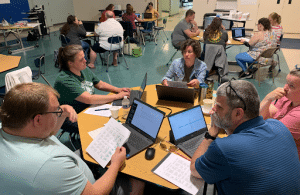
Learning From the Data
SAU 7 educators first completed a self-assessment using Vander Els and Stack’s CBL School Design Rubric in December of 2020, after being introduced to the seven design principles of competency-based learning. Then, after spending two and a half years deeply engaged in work to deepen and refine competency-based practices in the schools, another self-assessment was administered. The following charts compare, for each design principle, the percentage of survey respondents that rated the school system beyond the initiating level (developing or performing). It can be observed that for every indicator and every design principle, there was at least some growth in the district’s movement beyond the initiating level.

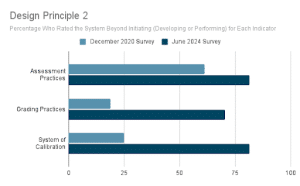
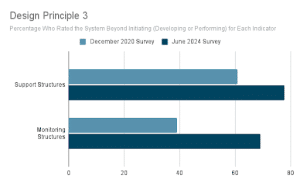
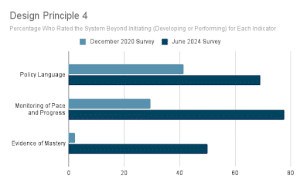
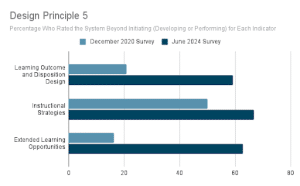
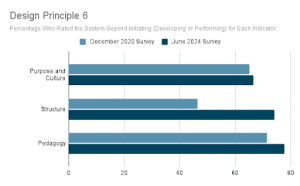
Conclusion: Building a Roadmap for On-Going Collaboration and Improvement
The journey for every school district that undertakes the change process is going to be a bit different. However, there are a number of similarities for educators undertaking transformation. A constant in this process is that change is difficult. In Stack and Vander Els’ work with many schools and districts across the country, there are some key structural elements and mindsets/beliefs that consistently lead to successful implementation.
First, in districts and schools that are engaged in change, there exists a strong collaborative leadership model. This team consists of teachers and administrators learning together and helps to both set the direction for the district, and also to move the work forward at the school and classroom level. This team learns together, and through this learning, engages others in the work. SAU 7 has multiple structures and opportunities for administrators and teachers to learn and move the work forward together.
There also exists a balance of pushing the work forward through the inevitable resistance, while also being flexible to provide additional support, or even slow down, when it is recognized as necessary to do so. For example, SAU 7 has been grappling with the role of “formative assessments” and the “weight” of these types of assessments. Although they recognize the need to move away from formative assessment practices as carrying weight in grades, this is a process that they will do slowly, as the understanding across all stakeholders continues to grow.
In schools and districts that continue to grow, there exists a “continuous learner” mentality. Administrators and teachers recognize that they are never “there” – that the students who walk through their doors each year have different needs, and that their work can always be refined and improved upon. This mindset drives the work forward, and serves as an exemplar for others who may be content to sit back. Complacency is the enemy of progress, and SAU 7, through strong leadership of administrators and teacher leaders, has not allowed their work (or their progress) to stall.
Engaging deeply in change always generates more questions that point to future directions. Teachers begin to seek out the questions before they even present themselves. The process they are a part of always illuminates the areas that need more attention. Instead of shying away from this, the educators in SAU 7 have begun to embrace this discomfort, knowing that by always pushing each other to be better, the next steps (rubrics and student agency, in the case of SAU 7), will guide their way to a more student-centered learning environment.
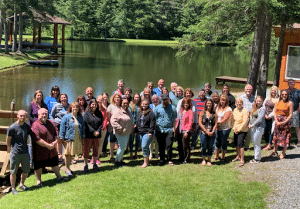
Learn More
- Educator Support in Competency-Based Learning Schools
- Building 21’s Leadership Competencies to Facilitate Competency-Based Learning
- Illustrating the Competency-Based Education Definition

Jennifer Mathieu serves as the Director of Curriculum, Instruction, and Assessment for SAU 7. She began her career with the district as a teacher in 2006 and later held the role of principal from 2014 to 2021. Jennifer earned both her Bachelor’s degree in Elementary Education and her Master’s degree in Educational Leadership from Plymouth State University. A native of the North Country, she returned to her roots to collaborate with the very educators who influenced her upbringing.

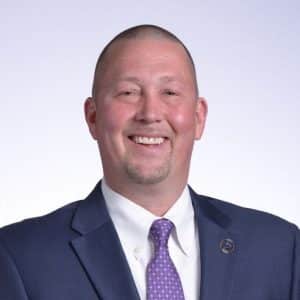
Brian M. Stack and Jonathan G. Vander Els have worked together for nearly two decades as New Hampshire school administrators leading this work in schools as early-adopters of CBE. Brian spent 16 years as a NH high school principal and is currently the Superintendent of Schools for the Fremont School District in New Hampshire. Jonathan was a NH elementary school principal and is now the Director of Collaborative Learning for the New Hampshire Learning Initiative. They have co authored three books together: Breaking With Tradition: The Shift to Competency-Based Learning in PLCs at Work™(2017), Unpacking the Competency-Based Classroom: Equitable, Individualized Learning in a PLC at Work® (2022), and their latest, written with Karin Hess, Elevating Competency-Based Learning in a PLC at Work®: Actionable Assessment, Defensible Evidence, and Equitable Grading (2025). Jonathan has also co authored with Joshua Ray The Foundation for Change: Focusing on the Four Pillars of a PLC at Work® (2024). All four are published by Solution Tree.
Brian and Jonathan work with educators around the country to refine and deepen their work. They are partners and lead associates of V&S School Solutions, a company that provides professional development services and support in the area of competency-based learning, structures to support personalized learning and assessment, and leadership development to schools around the country. They are also associates for Solution Tree, a global professional development provider. You can follow Brian and Jon on LinkedIn at @brianmstack and @jonathan-vanderels.
